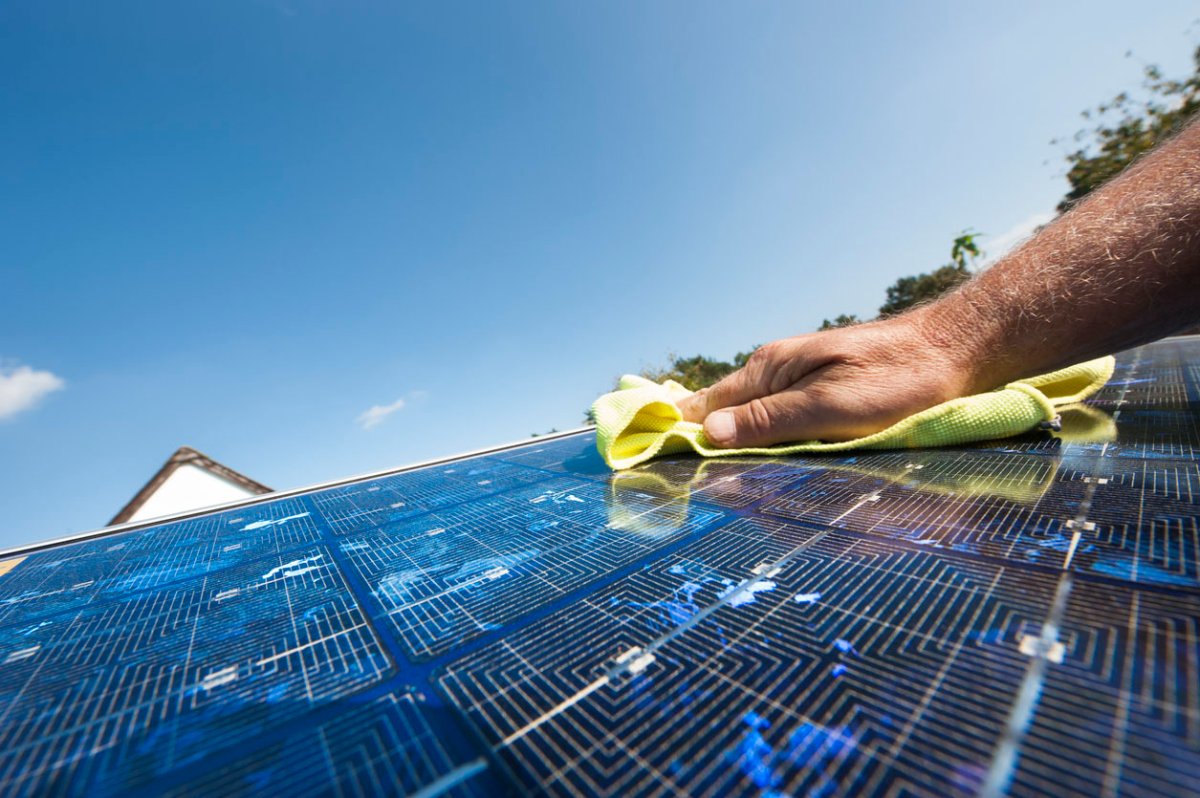

We may earn revenue from the products available on this page and participate in affiliate programs. Learn More ›
Project Overview
-
- Before cleaning solar panels, turn off power to them.
- Dislodge any loose debris or dust with a soft brush.
-
- Spray down the panels with a hose and scrub any stuck-on dirt areas gently with a soft brush and water or a special cleaning solution for heavily soiled areas.
-
- Dry the panels with a soft cloth or squeegee before restarting the system.
-
- If a homeowner doesn’t feel comfortable tackling this project themselves, a professional can help.
Solar panels are trending as a source of renewable energy as homeowners seek to lower energy bills and make their homes more self-sufficient. The benefits of installing solar panels on a home range from reduced monthly utility payments and a smaller carbon footprint to increased home value. The cost is even becoming increasingly attainable, especially with the help of a solar panel loan or incentives from local utilities.
However, solar panels need to generate enough energy to reduce the reliance on the grid to justify solar’s investment cost. So, it’s important to keep your solar panels clear of dirt and debris—all of which can limit the amount of sunlight exposure and the panels’ efficiency. Especially in dry climates or near construction sites, relying on rain to keep panels clean may not be enough. Learning to clean solar panels can even help homeowners save money on solar panel maintenance costs.
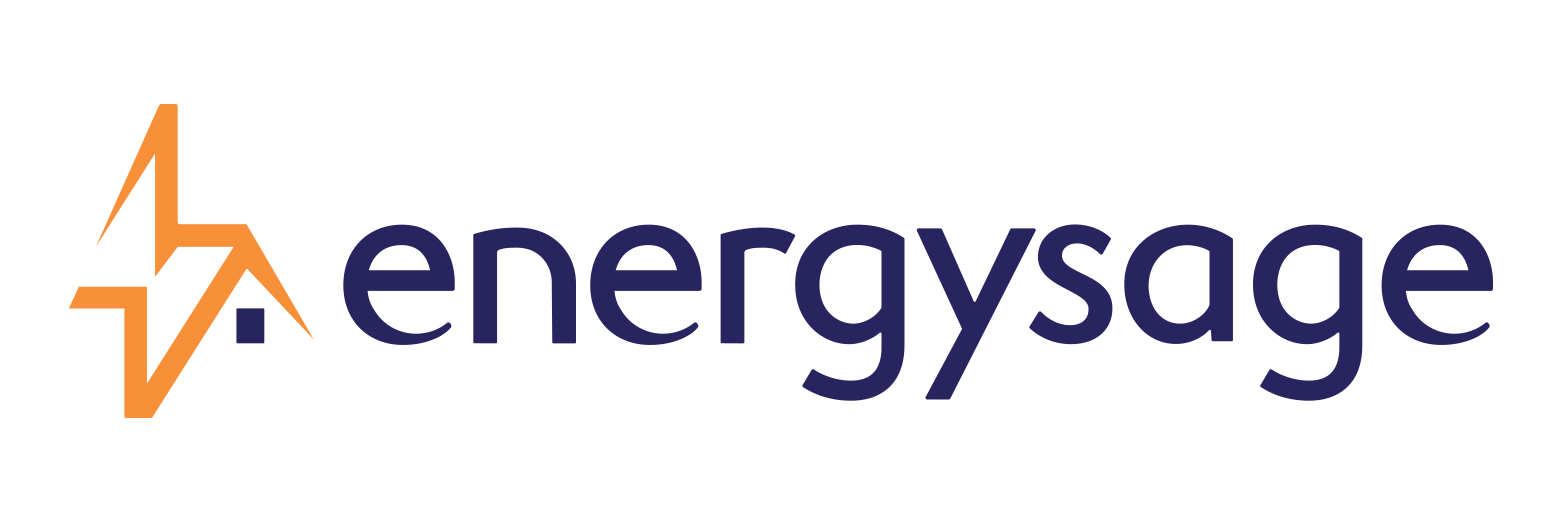
Start benefiting from solar.
Bob Vila has partnered with EnergySage to help you compare multiple quotes for rooftop solar panels from vetted installers in your area.Get Free Quotes
Even if they were installed by one of the best solar companies, solar panels need regular maintenance to remain at peak performance. With a few easy-to-find supplies, homeowners can learn how to clean solar panels on a roof or ground array safely to boost their efficiency, as well as determine when it might be best to hire professionals for solar panel cleaning.
Time required: 1 to 2 hours
Difficulty: Beginner
Estimated cost: $50 to $100 (when supplies are first needed)
Tools & Materials
Bobvila.com may earn a commission from purchases made through these links.
- Soft-bristle brush
- Toothpick
- Telescopic extension pole with threaded tip or hook
- Extension ladder (optional)
- Hard hat (if using extension ladder)
- Harness (if working on a roof)
- Work gloves
- Garden hose
- Telescopic hose wand (optional)
- Sponge, squeegee, or soft cloth
- Bucket
- Vinegar (optional)
- Gentle dish soap (optional)
- Glass cleaner (optional)
Before You Begin…
Not all solar panels have the same maintenance suggestions, so check manufacturer instructions before doing any DIY solar cleaning work. It’s also worth noting that, despite the higher initial cost of solar shingles, this type of solar roof may not require cleaning at all.
Unless you’re cleaning the portable solar panels, the system is likely located on the roof. In this case, weigh your ability to work safely when learning how to clean solar panels that are high up. If the solar panels are too high to reach comfortably with tools or are set in a steep or slippery location, professional assistance may help avoid potentially serious injuries.
Tips for Cleaning Solar Panels
- The best times to clean solar panels are cool, cloudy, and mild in temperature. Save this chore for the morning or evening of spring and fall months. Water will be less likely to evaporate too quickly and leave streaks behind.
- Never apply cold water to hot panels; this will cause them to crack.
- Use a small amount of gentle soap mixed with one part vinegar and eight parts water as an excellent homemade solar panel cleaning solution for cleaning the glass on solar panels. (Skip abrasive, heavy-duty detergent.)
Safety Considerations
- Solar panels must be turned off before cleaning, and the underside should never be touched.
- It’s safest to clean solar panels from the ground with extension tools while wearing gloves. However, two-story and three-story homes may require climbing up to the roof.
- Homeowners who are unsure of their ability to clean their solar panels safely will want to consider calling a local solar power professional to complete the job for them.
STEP 1: Gather non-abrasive supplies and safety equipment.
How do you clean solar panels the right way? It starts with having the proper items in hand. A solar panel cleaning kit may include all the necessary items. Generally, though, solar panels can be treated similarly to windows or other glass surfaces: Combine water with a mild soap to create a homemade solar panel cleaner. For scrubbing, a soft sponge or solar panel cleaning brush that will not scratch the surface of the panels will be sufficient. A lint-free cloth or squeegee can be used to remove excess water.
While standard hardware supplies can be used for a solar panel cleaning project, safety considerations are critical. A hard hat, ladder support, and harness are recommended for any homeowner who plans on cleaning solar panels on a roof instead of from the ground.
STEP 2: Turn off the solar panel system by following the manufacturer instructions.
If you’re attempting to DIY this chore, start by shutting the panels off. Solar panels are electrical equipment and cannot be cleaned while active due to the risk of electric shock. A solar panel manufacturer’s specifications will explain how to check that electrical currents—both produced by the panel and going into the home—are turned off.
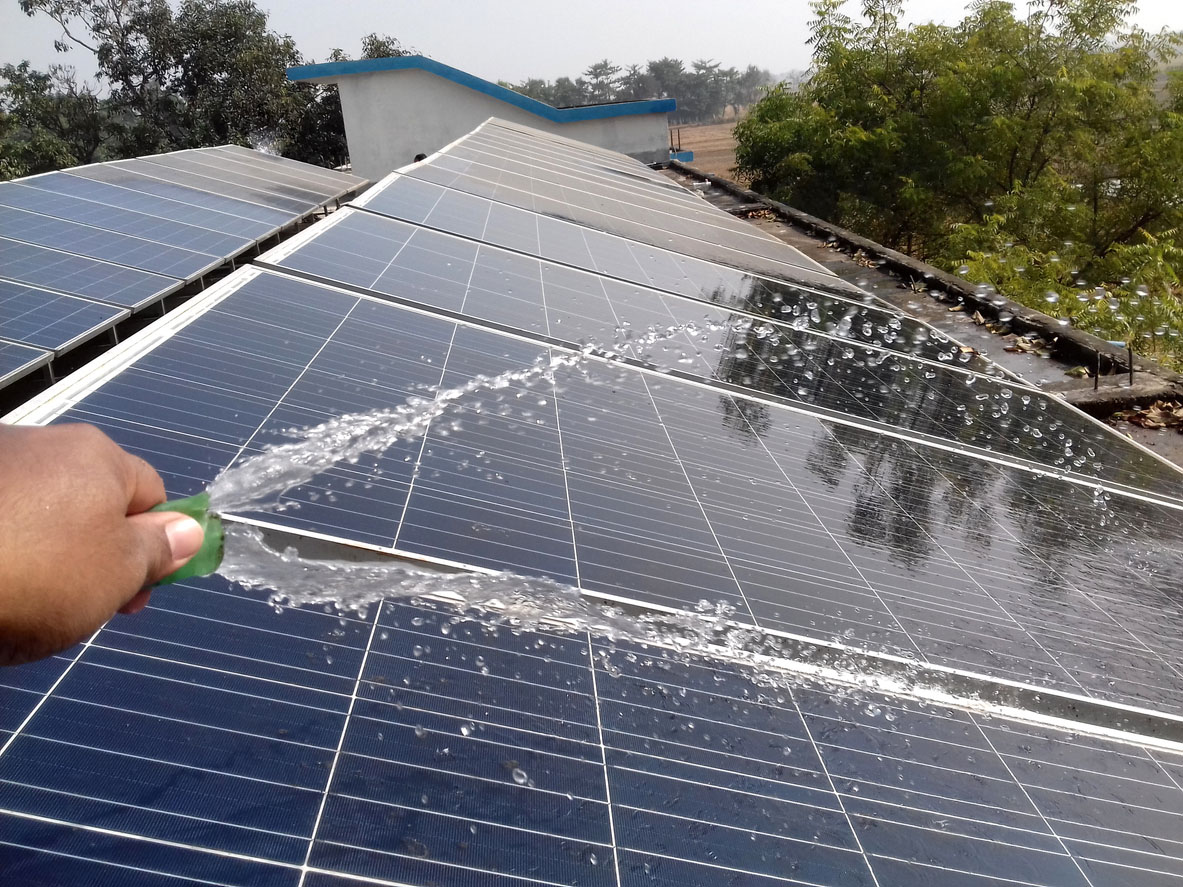
STEP 3: Dislodge any dust, dirt, or leaves with a soft brush.
Leaves, bird droppings, and dust accumulate on solar panels. Even though rain clears some of this, it doesn’t get everything and can create dirty residue when puddles evaporate. Debris can be removed with gentle brushing from a soft-bristled tool to start the cleaning process.
This can be done from the ground if the soft brush is attached to a telescopic extension pole with a threaded tip or hook. Some poles can extend to 24 feet. Without a long enough extension pole, reaching solar panels will require an extension ladder. If the task requires climbing onto the roof, take safety precautions, like wearing a hard hat and harness.
The best way to clean solar panels starts with a gentle brushing. Otherwise, if a lot of material is sitting on solar panels, immediately mixing the debris with water might cause spread and smear. Brushing breaks down and removes some material, making the next steps in the cleaning process more effective. Wear work gloves to keep your hands clean and safe.
If you’re on the roof to clean, check whether the panels have drainage holes and ensure that those are clear, too. These holes will be located along the sides of the panels and can be cleaned by inserting a toothpick inside.
STEP 4: Use a garden hose to spray the panels clean.
After dry debris is removed by brushing, a garden hose can clear most remaining dirt on solar panels.
Remove any high-pressure attachments before cleaning your solar panels. It may be tempting to hit solar panels with as much water as possible to get the job done quickly, but high-pressure cleaning is likely to create fine cracks on their surfaces. This will ruin the efficiency of the solar system and cause future problems. It may also void existing warranties due to noncompliance with manufacturer specifications for solar panel maintenance.
The key is careful, deliberate spraying along each solar panel. Try a telescopic hose wand if a garden hose doesn’t offer enough spraying control. This will have a more supportive grip than a hose on its own.
STEP 5: Scrub any problem areas with a soft brush and water.
Give problem areas extra attention with a sponge, squeegee, or soft cloth dunked into a bucket of clean water. Gentle, focused cleaning in a repetitive motion—with some patience—is best since aggressive scrubbing can scratch the panels.
Even cleaning products deemed “safe” for use on solar panels can be abrasive. Water is the best solar panel cleaner, especially if it’s deionized or distilled. This water attracts other chemicals, so it’s more efficient for cleaning. If deionized or distilled water isn’t available, treating hose water with a water softener can help improve its cleansing power.
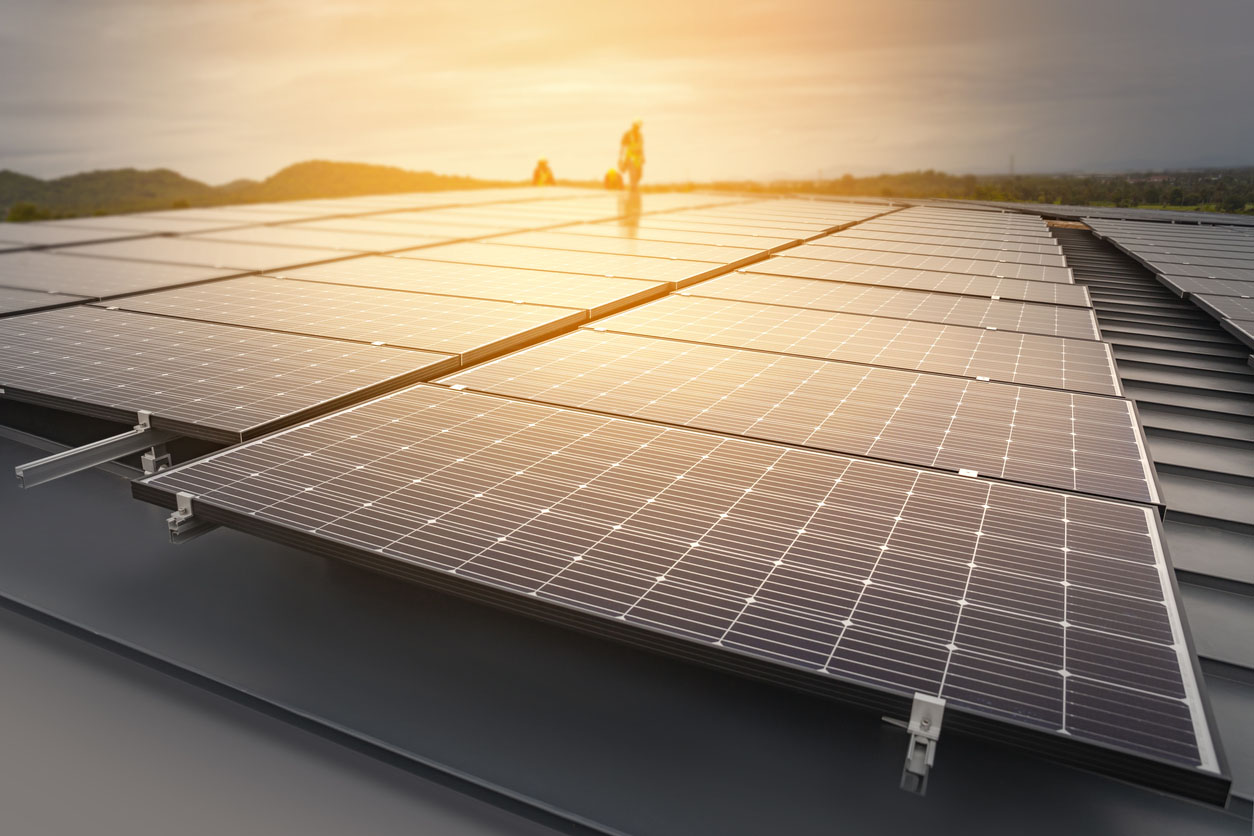
STEP 6: Apply a cleaning solution for heavily soiled areas, making sure to wipe and rinse the solution thoroughly.
To tackle any stubborn spots, mix a squirt of mild dish soap with one part vinegar and eight parts water. Any soap will need to be used sparingly and with caution. When soap is rinsed, it can leave a residue that dirt clings onto in the future, leading to streaky solar panels. Not only is this less aesthetically pleasing, but it can also compromise some of the panels’ functionality.
Glass solar panel cleaners can also be used instead of soap as they are typically designed not to leave unsightly streaks. However, strong chemicals are not recommended as they can damage the surface of the panels.
STEP 7: Use a squeegee or soft cloth to thoroughly dry the panels once clean.
To avoid hard water marks and streaks, each panel will need to be dried thoroughly. If using a squeegee, begin at the top of the panel and work in downward strokes until the entire panel is dry. Additional drops can be wiped up with a cloth. Be selective about the kind of cloth used to dry the panels; even a seemingly soft towel can accidentally leave scratches on the panels’ surface.
STEP 8: Know when to call a professional.
Depending on how many solar panels are needed to power the home, as well as how accessible they are from the ground, solar panel cleaning can be a challenging and lengthy process. Plus, an excessive amount of debris might be too much for a garden hose and sponge. Whenever cleaning solar panels seems more daunting and dangerous than beneficial, don’t hesitate to call in the pros. (As a rule of thumb, only solar panels that are easy and safe to access should be cleaned without professional services.)
In some cases, the solar panel installation company that installed the system may offer this service. You can also hire companies that clean solar panels exclusively.
To get the most out of a professional solar panel cleaning service, you can always begin a “light” version of the cleaning process by clearing leaves or large debris—just enough to get a good idea of specific cleaning problems that need to be addressed.
STEP 9: Restart the system and monitor your home’s solar output to measure the cleaning’s impact.
More access to direct sunlight should increase your panels’ solar output (e.g., how much power they produce). To determine how much impact cleaning solar panels has, review your energy bills before and after the cleaning.
Based on the specifics of the solar system, its location, and environmental factors, solar panels are rated for a solar output within a specific range of watts. Normal operating conditions cause fluctuation within the predicted range. When solar panels are dirty, however, they produce energy at the low end of the range. With a lower solar output, homeowners rely on power from an additional energy provider, driving up energy bills and time in the solar payback period. Clean solar panels will have lower energy costs because they allow maximum exposure and higher solar output.
Why do solar panels need to be cleaned?
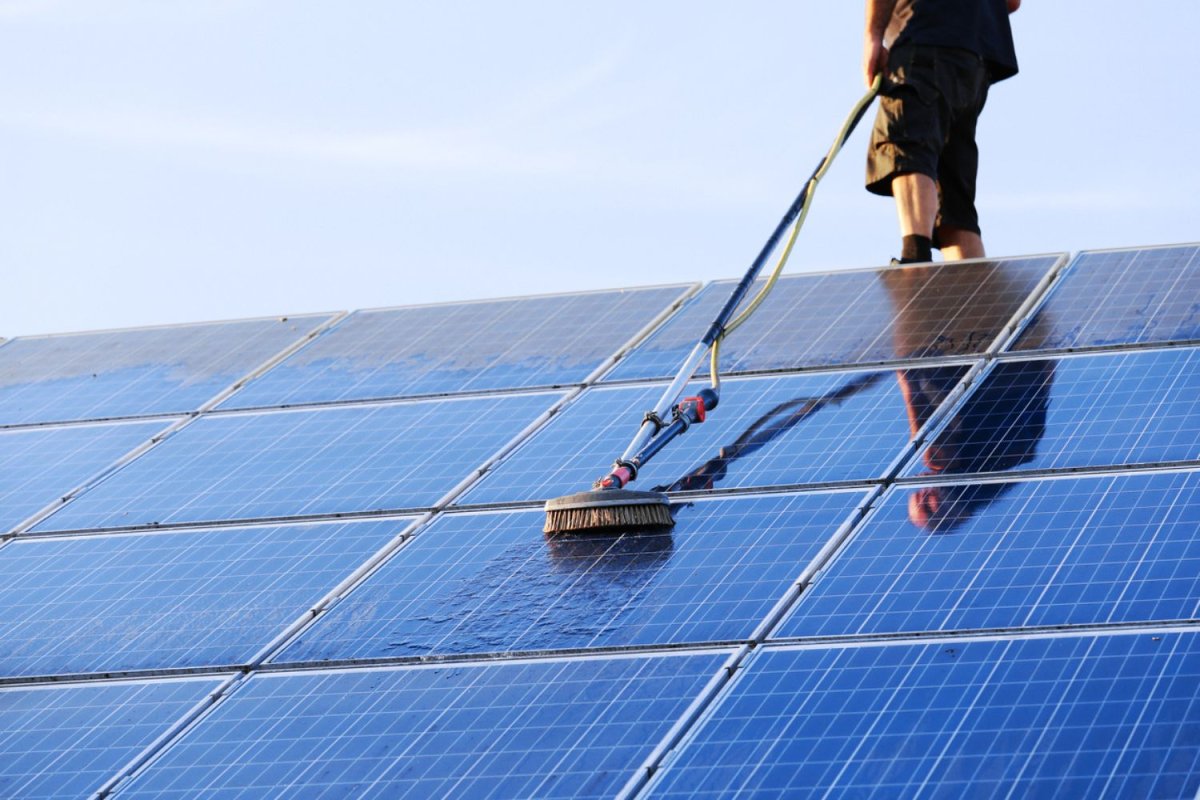
Located on a home’s roof, solar panels are bound to accumulate dust, dirt, leaves, bird droppings, and other debris. Buildup occurs even more quickly for panels that are completely horizontal, which rain cannot simply rinse off. Cleaning solar panels can help keep them operating at maximum efficiency, as well as prolong the solar panels’ lifespan. Failure to clean the panels regularly may even cause homeowners to void their solar panel warranty.
How often do solar panels need to be cleaned?
In most cases, cleaning solar panels once or twice a year is typically sufficient. However, the exact frequency can depend on a few factors:
- Local precipitation. In general, solar panels require less cleaning and maintenance in areas that receive regular precipitation. In regions that receive relatively low amounts of rainfall, however, panels should be cleaned more often.
- Roof pitch. Homes whose roofs have little to no slope may also need more frequent cleaning.
- Nearby construction. If a neighbor is having construction done to their home, a cleaning may be necessary after the project is completed to remove any dust that has settled on the panels.
